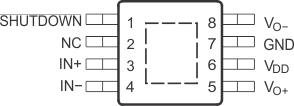SLOS369G July 2002 – October 2015 TPA2005D1
PRODUCTION DATA.
- 1 Features
- 2 Applications
- 3 Description
- 4 Revision History
- 5 Device Comparison Table
- 6 Pin Configuration and Functions
- 7 Specifications
- 8 Parameter Measurement Information
- 9 Detailed Description
- 10Application and Implementation
- 11Power Supply Recommendations
- 12Layout
- 13Device and Documentation Support
- 14Mechanical, Packaging, and Orderable Information
Package Options
Refer to the PDF data sheet for device specific package drawings
Mechanical Data (Package|Pins)
- DGN|8
- DRB|8
Thermal pad, mechanical data (Package|Pins)
Orderable Information
6 Pin Configuration and Functions
GQY and ZQY Packages
15-Pin MicroStar Junior™
Top and Side Views

DRB Package
8-Pin VSON
Top View

DGN Package
8-Pin HVSSOP
Top View

A. The shaded terminals are used for electrical and thermal connections to the ground plane. All the shaded terminals need to be electrically connected to ground. No connect (NC) terminals still need a pad and trace.
B. The thermal pad of the DRB and DGN packages must be electrically and thermally connected to a ground plane.
Pin Functions
| PIN | I/O | DESCRIPTION | ||
|---|---|---|---|---|
| NAME | GQY, ZQY | DRB, DGN | ||
| GND | A2, A3, B3, C2, C3, D2, D3 | 7 | I | High-current ground |
| IN- | D1 | 4 | I | Negative differential input |
| IN+ | C1 | 3 | I | Positive differential input |
| NC | B1 | 2 | No internal connection | |
| SHUTDOWN | A1 | 1 | I | Shutdown terminal (active low logic) |
| Thermal Pad | Must be soldered to a grounded pad on the PCB. | |||
| VDD | B4, C4 | 6 | I | Power supply |
| VO- | A4 | 8 | O | Negative BTL output |
| VO+ | D4 | 5 | O | Positive BTL output |